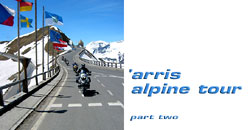
|
|
||||||||
PART 2 - GROSSING THE GLOCKNER
 |
| Manfred gives the thumbs up as we take a break up the near the top of the Glockner. |
Note - If you missed part one, go here.
I awake at 7:04am and ponder whether another half hour’s shut-eye might help to rescue my head from yet another alcohol-induced pain. Despite great plans to restrain from the evils of drink, the evening ended up in the hotel’s wine cellar and the result became an inevitability.
At 7:05am, the morning sun decides for me, clearing the wall of rock immediately to the east, and lighting up the hotel room like a dozen 1000-Watt bulbs. In the Alps, the rising sun has a knack of doing this, as it has to climb huge mountains before it can illuminate the valleys below – thus bypassing the slow filtering stage of the dawn hour and jumping in suddenly at full strength as if operated by an on/off switch.
What I needed now was to find coffee and food so that I could also ingest a last dose of ‘Alphetamine’, for today was the last on this short but sweet expedition. It was also going to be a long one, thanks to a planned excursion to the one of the highest and most famous passes of the region – the Grossglockner.
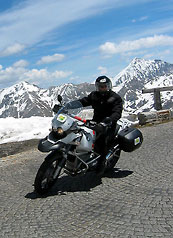 |
The big GS1150 is fun in the switchbacks. Photo: Manfred the guide |
Body somewhat regenerated, we wasted no time and left the hotel's parking lot and immediately started for the next mountain. By now it was the norm to be swinging through switchbacks, up and down passes, punctuated only by much welcomed Cappuccino breaks. I’d even mastered the quick hangover cure, consisting of aggressively attacking the first few switchbacks and letting the resulting adrenaline do the rest. If I needed a double shot, a glance over the barrier mid-corner usually did the job.
By late morning I was fully human again, and just in time, as we veered off and left the confines of a valley floor on our grand ascent of the Grossglockner. It’s a popular old road, especially amoungst motorcyclists, a crowd of which were stopped at the tollbooths ahead. Entry for this ride is a pricey 17 Euros (about C$28.00), but it’s a grand ride worthy of every cent.
About half way up there’s a side-road to a viewing point of Grossglockner mountain (Europe’s highest), overlooking a rapidly diminishing glacier. Unfortunately the viweing point is choka with buses, bikes and cars. However, I guess since you’ve already paid for it, it’s worth a visit, but the real fun is to be found back at the pass ...
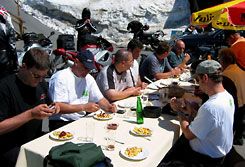 |
The dessert gets photographed by apprehensive Canadians. Photo: Manfred the guide |
The switchbacks seem to go on forever, but this road is also wider than most that we’ve traveled, testament to its popularity with tourists. Strangely I didn’t much care for this, as I’d now gotten used to the nastier, narrower passes of the previous days. Then – as if answering my demand for more of a challenge – we hit the snow line, and the road becomes an asphalt channel between high snow banks, the occasional stream of melt-water adding to the mid-corner 'excitement'.
Here the air is crisp and cool and we divert up to the Edelweiss-Spitze, the highest point of the pass and our lunch-stop for the day. At 2,571 meters you’re really on top of the world and the view testifies to this. I resist the call of the Japanese tourist and chow down on more vegetarian-friendly fancy Kraft dinner. This is followed by an interesting omelette-based dessert that also looks like something that may just have well have come up as about to go down. Still, it tasted pretty good and had the courtesy to not make a return journey later in the day.
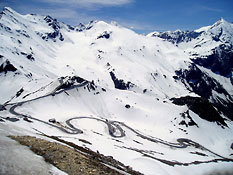 |
| The view from here .. the roads up here. Here. |
The descent of Grossglockner also signifies the end of the High-Alpine passes and before long we find ourselves on the Autobahn into Munich. Contrary to popular belief, it’s not a free-for-all without limits. Two of the three lanes are like any other highway in the world – sedate. It’s the third lane where you can go mad.
So we did.
The rung-out GS Adventure edges up to an indicated 200 km/h, although shoulder buffeting is making the bars wiggle, requiring a one-handed effort – other arm behind my back – with upper body leaned into the screen. Things come quickly at this speed, and you have to pay particular attention to middle lane traffic pulling out at a paltry 130km/h. But it’s a novel feeling ... well, in so far as not having to keep an eye for police traps anyway.
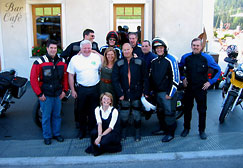 |
We seem to be a happy bunch – even Bruce Reeve manages to crack a smile (far right)! Photo: Manfred the guide |
A turn-off the Autobahn also signifies the end of the fun and within minutes we’re rolling back into Muenchner Freiheit (MF) headquarters. It's only been a three-day trip, but I feel that I've been riding for a week – such is the shear mass of ecstatic roads, amazing views and, err, evening over-indulgences.
Although this trip was a specially constructed one for the sake of a bunch of Canadian journalists, Hermann (MF's big cheese) reckoned that it would probably cost in the region of Euro 1000 (about C$1640.00). You’d have to add airfare and booze (significant in my case) to that, but to fly in and then fly out straight afterwards would be foolish. You’re there to ride, so if you want to do the tourist bit as well, consider renting a car and doing it again at a more sedate pace.
Or rent a bike and do it again.
And again.
And again.
MUENCHNER FREIHEIT (MF)
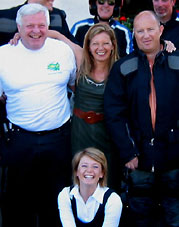 |
Hermann Weil (left) is seemingly always happy. Photo: Manfred the guide |
Started in 1980 by Hermann Weil (a remarkably calm and happy man) MF is part of the BMW sponsored touring program, with a fleet exclusively made up of BMWs. The bikes are well maintained and updated with new models regularly. You can swap around during the tour so that you can have a go on the different models. Each bike is also equipped with hard panniers to carry your trip luggage, and you can leave your suitcases back at MF’s offices.
The company only offers guided tours and although they supply the bike, they do not rent-out their motorcycles. The guides know the best routes and, more importantly, the way to the hotel at the end of the night. You’re paying for this service and it’s a much better ride when you merely follow and absorb what’s around you instead of stopping every five minutes to look at a map of squiggles.
Although their brochure only shows set tours, they can offer any tour that takes your fancy, with any number of riders. So a trip to Outer Mongolia with you and a guide is possible, although likely a tad expensive.
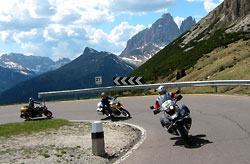 |
The pace is dictated by the group. Photo: Manfred the guide |
The pace at which the guide takes the group depends on what the group is comfortable with. Being a bunch of speed-hungry journalists we went at a decent clip, but the guide would always keep an eye on the back-marker and pull the group to the side of the road at any turning point if the back-marker was being particularly slow.
It’s very important not to try any risky passing, especially in the Alps. Don’t worry, you won’t get left behind, so take your time and keep a good 15% in your back pocket, just in case.
WHAT’S INCLUDED?
All tours come with a guide, motorcycle, food and accommodation. In fact they cover most everything except gas for the bike and booze for you. Oh, and you’ll have to cover your own flight in and out. There are also extras that you can bolt-on for a price. We had a sweep truck that proved handy for carrying extra luggage, providing drinks at stops and making sure that the slower journalists didn’t get too lost.
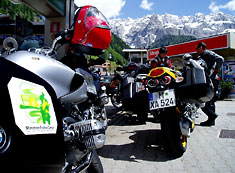 |
| Buy your own gas, but get to the pump first! |
The guides have an extensive knowledge of the local area and more importantly, roads. If all the guides are anywhere near the caliber of our Manfred then you can’t go wrong. He managed to keep the group together and in one piece, would order refreshments at each stop before we’d even got our helmets off and stop slow buses to let the rest of the group get by. He also spent half the trip shooting photos – backwards, mid-corner with large drop-offs to the side. Pictures came out surprisingly sharp too, considering.
The accommodation that we sampled was excellent. Perfect examples of Alpine hotels with all the mod cons … except for high-speed Internet and clocks. Yes, no clocks. What’s with that then? Oh, and good luck trying to use the phone system in Italy.
The food was pretty good too. Since Germany is ‘zee land ov pork’, you should try some of the local piggy dishes, but if you’re vegetarian there’s always the salad bar and quite often a local pasta and cheese dish. I forget what it’s called, but it was like a very fancy Kraft dinner. Oh dear, my pants have shrunk.
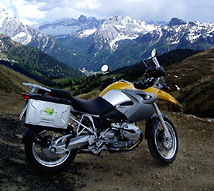 |
| It can get a bit chilly at the top of the passes. |
Rider and (comprehensive) motorcycle insurance are also provided, and if you happen to have a mishap or the bike gets sick, they will provide a replacement within 24 hours. That’s providing that you didn’t cause the damage through “intent or gross negligence” of course.
They do not rent helmets or riding gear so don’t forget to bring your own. Also, since it can get bloody cold at the tops of the passes, bring warm stuff. An electric vest would be very handy here as you can just plug it in as you ascend and unplug it again on the way down.
You’ll also need a licence. I’m not sure if a Canadian licence is valid there or not, but I am sure that an International one is, and they only cost about $20 from your local CAA shop.
BEST TIME TO TOUR THE ALPS?
 |
We were there in early to mid-June and it would appear that we pretty much hit the best time of year, showing up after two weeks of rain and then leaving just before the next front moved in. Although the weather is always a matter of luck, the beauty of June is beating the masses onto the roads, as school isn’t out for another month, after which congestion would likely be a bit of an issue.
There’s also a lot of light so you can maximize your riding days while taking in the masses of spring flowers (bring allergy medication), Geranium-filled flowerpots, snow-capped mountains and gorges gushing with melt-water. The only downside is that not all of the passes may be open yet. Yes, they’re that high and can still be bloody cold and covered in snow, even in early June.
GENDARMES
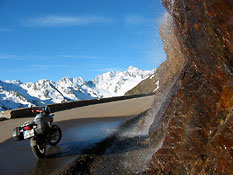 |
Technical roads with large drop-offs can be hazardous enough. Wet patches from melt-water add to the excitement. Photo: Manfred the guide |
Are relatively rare and tend to hang out around the outskirts of towns and villages on the few stretches of road long enough to be able to actually pull anyone over. Thankfully there’s also a good camaraderie amoungst bikers, and if you see one approaching with hand out “patting the dog”, that means slow down – Gendarmes ahead.
BE SAFE
Finally, it’s probably worth noting that if you are going to do an Alpine tour (and it is highly recommended) you should be confident of your riding skills and ability to know when or when not to make that pass.
The roads can be extremely technical and if you get a corner wrong it might not be just a matter of falling into a three-foot deep ditch – the ditches here can be a good couple of thousand feet! They’re also pretty narrow and can be busy, so going wide on a corner can be easily done, and you may end up meeting another vehicle head on.
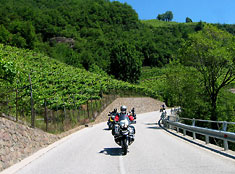 |
|
The diversity of the Alps includes many a vineyard, and the resulting local wine can be excellent. Just try and keep a clear head for the next day! Photo: Manfred the guide |
Same goes for passing. There are tour buses galore and when you just have a road made up of only corners, plodding along at a little above running pace, looking at the flat arse of a bus, and the temptation to pass on a guess is a strong one. Know the bike’s abilities and only pass when you’re sure. It comes quite naturally after a while.
Although I had a couple of heart-in-mouth moments on my three-day tour (mainly because I’d let my mind wonder or was trying to get an eyeful of scenery when the road demanded my full attention) I’ve never been to such a massive and concentrated motorcycle Mecca in all my life. And to opt to miss this life-experience on the grounds of safety would question the whole point of you riding a bike in the first place.
It’s an area of the world that is a “must do before I die” for every motorcyclist. Although you can do it on your own (ship-in or rent a bike there), a guided tour is a very easy way to get the maximum experience for minimum time and effort. M.F.'s prices seem reasonable, but if you somehow find yourself in Europe with a bike, be sure to include this motorcycle wonderland in your itinerary.
Just respect the roads, embrace the culture and have fun.
MORE INFORMATION
Web: www.muenchnerfreiheit.de/english/index.htm
or http://www.bmw-motorrad.com/com/redirects/travelpoint.html
Email: info@muenchnerfreiheit.de
Phone: +49-89-395768
![]()